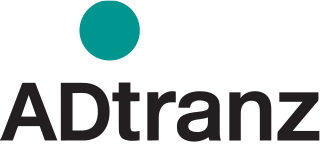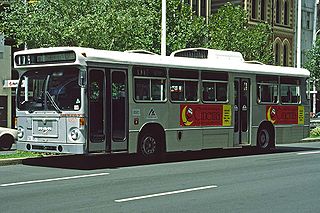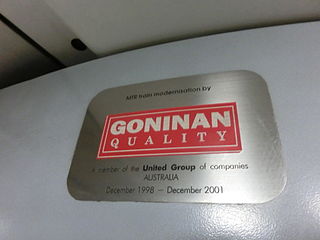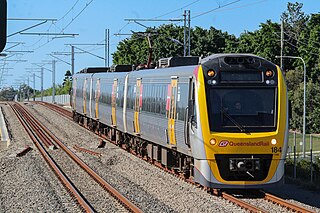
A diesel multiple unit or DMU is a multiple-unit train powered by on-board diesel engines. A DMU requires no separate locomotive, as the engines are incorporated into one or more of the carriages. Diesel-powered single-unit railcars are also generally classed as DMUs. Diesel-powered units may be further classified by their transmission type: diesel–mechanical DMMU, diesel–hydraulic DHMU, or diesel–electric DEMU.

Adelaide Metro is the public transport system of Adelaide, the capital city of South Australia. It is an intermodal system offering an integrated network of bus, tram, and train services throughout the metropolitan area. The network has an annual patronage of 79.9 million, of which 51 million journeys are by bus, 15.6 million by train, and 9.4 million by tram. The system has evolved heavily over the past fifteen years, and patronage increased dramatically during the 2014–15 period, a 5.5 percent increase on the 2013 figures due to electrification of frequented lines.

Hyundai Rotem is a South Korean company that manufactures rolling stock, defense products and plant equipment. It is a part of the Hyundai Motor Group. Its name was changed from Rotem to Hyundai Rotem in December 2007 to reflect the parent company.

Adtranz was a multi-national rail transportation equipment manufacturer with facilities concentrated in Europe and the US. The company, legally known as ABB Daimler-Benz Transportation was created in 1996 as a joint venture between ABB and Daimler-Benz to combine their rail equipment manufacturing operations. In 1999, DaimlerChrysler bought ABB's shares and changed the company's official name to DaimlerChrysler Rail Systems. The company was acquired by Bombardier Inc. in 2001, which merged it into its Bombardier Transportation division, which became the largest rail equipment manufacturer in the world at the time.

TransAdelaide was a publicly owned corporation established in July 1994, which provided suburban train, tram and bus services in Adelaide, South Australia, under contract to the Government of South Australia. It took over these responsibilities from the State Transport Authority.

The rail network in Adelaide, South Australia, consists of four lines and 89 stations, totalling 132 km (82 mi). It is operated by Keolis Downer under contract from the Government of South Australia, and is part of the citywide Adelaide Metro public transport system.
Bombardier Transportation was a Canadian-German rolling stock and rail transport manufacturer, headquartered in Berlin, Germany. It was one of the world's largest companies in the rail vehicle and equipment manufacturing and servicing industry. Bombardier Transportation had many regional offices, production and development facilities worldwide. It produced a wide range of products including passenger rail vehicles, locomotives, bogies, propulsion and controls. In February 2020, the company had 36,000 employees, and 63 manufacturing and engineering locations around the world. Formerly a division of Bombardier Inc., the company was acquired by French manufacturer Alstom on 29 January 2021.

The 3000/3100 class are a class of diesel railcars operated by the State Transport Authority and its successors in Adelaide. They were built by Comeng and Clyde Engineering between 1987 and 1996 and are the workhorse of the non-electrified suburban rail network in Adelaide.

The B-series trains are a class of electric multiple unit built by Downer Rail in Maryborough, Queensland for Transperth between 2004 and 2019.

The Gawler railway line, also known as the Gawler Central railway line, is a suburban commuter railway line in the city of Adelaide, South Australia. The Gawler Line is the most frequent and heavily patronised line in the Adelaide rail network.

The Seaford railway line is a suburban commuter line in Adelaide, South Australia.

The Flinders railway line is a suburban commuter line in Adelaide, South Australia, that branches off the Seaford line at Mitchell Park, and ends opposite Science Park, close to the Flinders University and the Flinders Medical Centre. The line is single track for most of its length, from Celtic Avenue, near Mitchell Park station, to its terminus.

UGL Rail is an Australian rail company specialising in building, maintaining and refurbishing diesel locomotives, diesel and electric multiple units and freight wagons. It is a subsidiary of UGL Limited and is based in Melbourne, with a staff of 1,200 across Australia and Asia. It operates factories in Broadmeadow, Maintrain Auburn, Spotswood and Bassendean. While it used to operate a factory in Taree, the plant was shut down and the equipment sold off.

CRRC Changchun Railway Vehicles Co., Ltd. is a Chinese rolling stock manufacturer and a division of the CRRC. While the CRV emerged in 2002, the company's roots date back to the establishment of the Changchun Car Company in 1954. The company became a division of CNR Corporation before its merger with CSR to form the present CRRC. It has produced a variety of rolling stock for customers in China and abroad, including locomotives, passenger cars, multiple units, rapid transit and light rail vehicles. It has established technology transfer partnerships with several foreign railcar manufacturers, including Bombardier Transportation, Alstom, and Siemens Mobility.

The 2000/2100 class were a class of diesel railcars operated by the State Transport Authority and its successors in Adelaide. They were built by Comeng in Granville, New South Wales in 1979–1980.

The Scharfenberg coupler is a commonly used type of fully automatic railway coupling.

The Interurban multiple units (IMU) are a class of electric multiple units manufactured by Walkers Limited/Downer EDI Rail, Maryborough for Queensland Rail's Citytrain division between 1996 and 2011. The IMU is divided into in three subclasses, units 101-110 as the 100 series, units 121-124 as the 120 series, and units 161-188, as the 160 series.

The Alstom Aventra is a family of electric multiple unit (EMU) passenger trains produced in the United Kingdom, originally by Bombardier Transportation and later by Alstom, as a successor to the Bombardier Electrostar. A large proportion of its design is based on the Electrostar, adding new technologies and achieving compliance with more stringent requirements and operator demands.

The Transperth C-series trains are a planned class of electric multiple units part of Alstom's X'Trapolis family of trains for Transperth that are being delivered as part of Metronet. The trains will be operated on Perth's suburban rail network.
The Dandenong rolling stock factory in South Dandenong, Melbourne, Australia was opened in 1954 by Commonwealth Engineering, it has since been operated by ABB, Adtranz and Bombardier and Alstom.



















